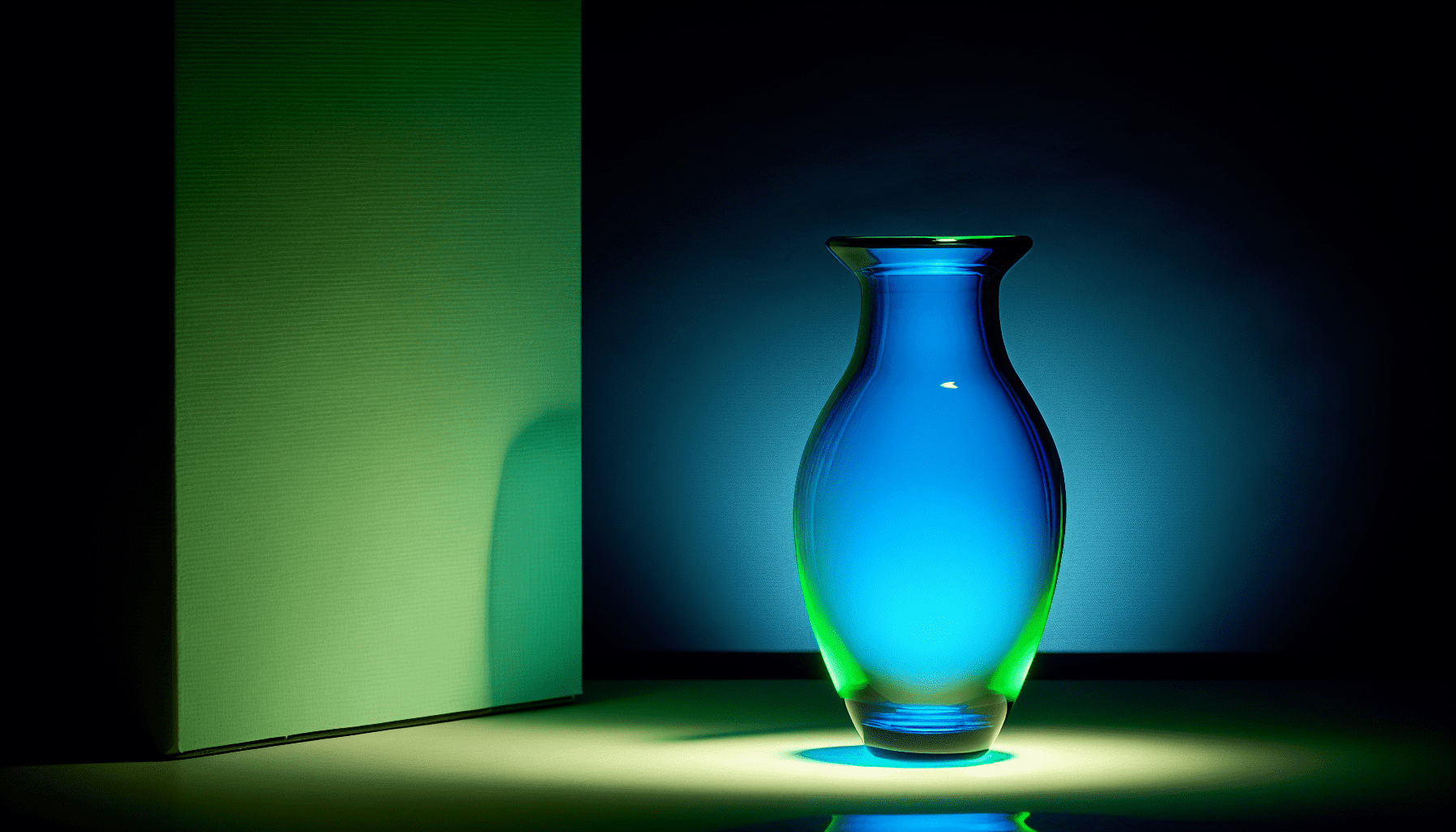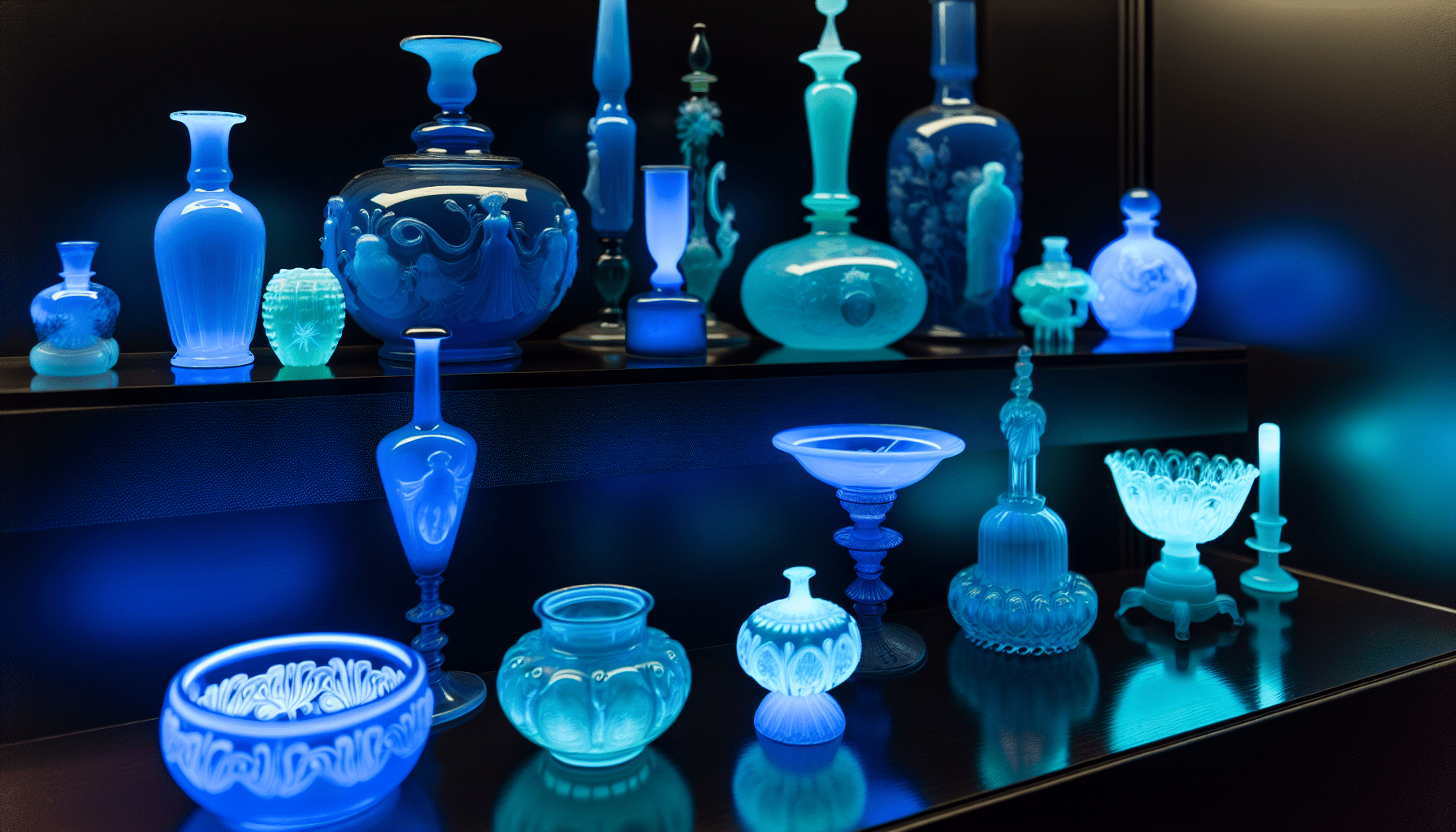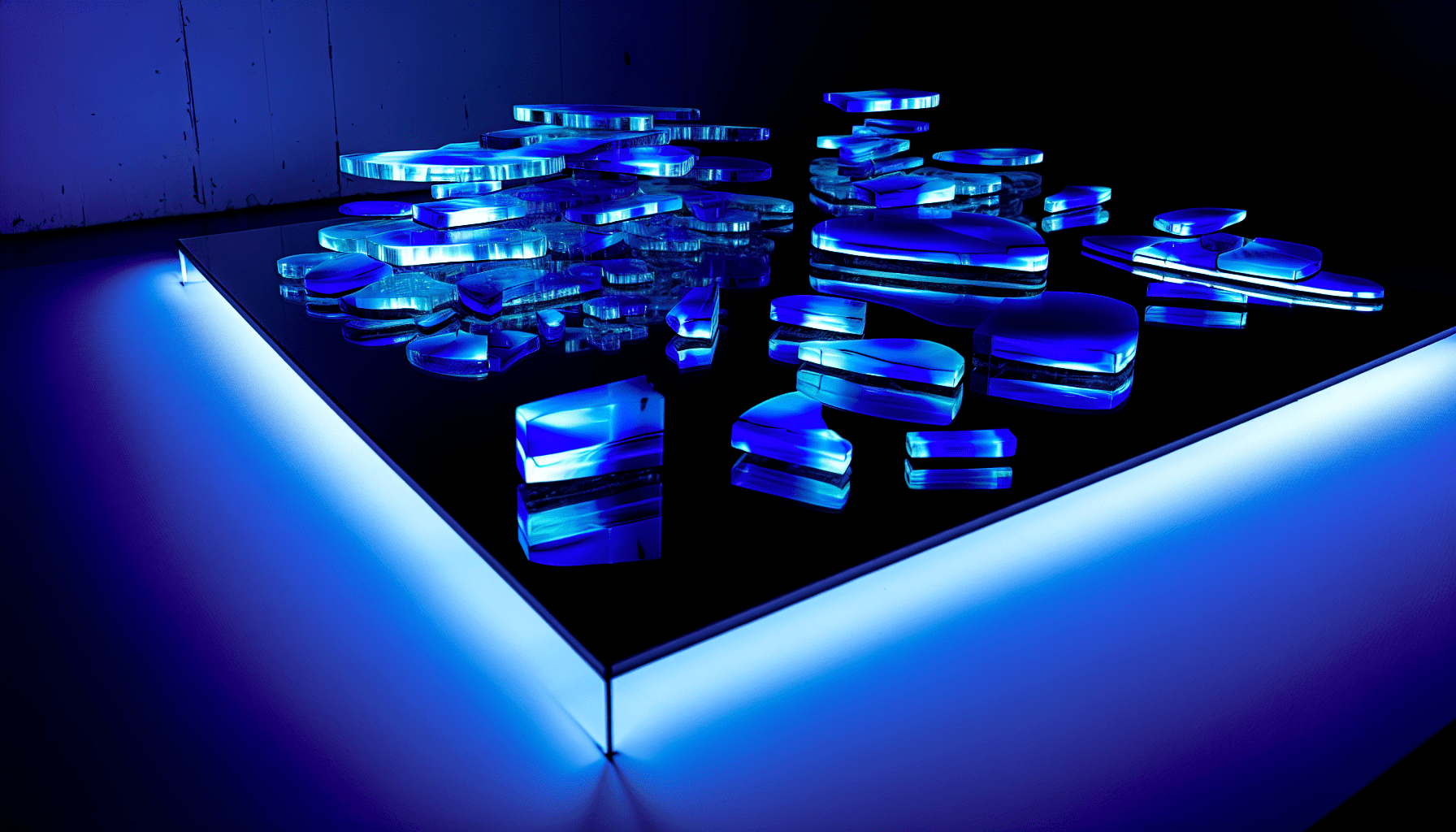Blue uranium glass is prized for its striking color and mysterious glow. Incorporating uranium into its composition, it stands out for its enchanting fluorescence under UV light. But what exactly is blue uranium glass, and what should collectors know about its safety and authenticity? This article uncovers the allure behind these glowing artifacts, guides you through authentication, and addresses safety, to help you appreciate the sophistication and intrigue it brings to any collection.
Key Takeaways
Blue uranium glass, known for its alluring glow under UV light, combines uranium oxide and sometimes iron oxide, dating back to the 1830s with varying fluorescence which aids collectors in identifying authentic pieces.
The production of blue uranium glass is a delicate art that involves blending uranium with other colorants like iron to achieve its unique color, considering both aesthetic and safety aspects due to the radioactivity of the materials.
Authentic blue uranium glass is distinguishable by its bright green glow under UV light and requires careful handling and maintenance, with safety in mind due to its low level of radioactivity, and should not be used for eating or drinking.
Discovering Blue Uranium Glass

Uranium glass, also known as custard glass due to its unique hue, is a fascinating material made with uranium oxide that imparts it with its characteristic color. When subjected to UV light, the presence of uranium and occasionally iron oxide in the glass causes an entrancing glow unlike other types of glassware.
This luminescent effect in uranium glass under UV light isn’t simply visually arresting—it signifies the intriguing blend of chemical science and creative craftsmanship.
Origins and History
Uranium glass, with its unique blue hue and originating in the 1830s, embodies the innovation of early glassmakers. Josef Reidel is often recognized for his pioneering role in blending uranium into the craft of glass production. The onset of World War II brought a hiatus to this practice due to limited availability of uranium supplies. Post-war productions were revived using depleted uranium.
Initially known as ‘Canary glass’ during the 1840s, what we now call Vaseline glass has undergone changes in nomenclature over time. From the period between 1958 and 1978, there was an impressive output from the United States amounting to more than four million pieces of Vaseline Glass, which included up to two percent uranium by weight in their composition.
Characteristics
Uranium glass, particularly the blue variety, is a subject that garners considerable interest among enthusiasts and collectors due to its striking color and unique glow. The level of fluorescence this type of glass displays when exposed to UV light can vary depending on how much uranium it contains. For those who collect such items, carrying a portable UV light becomes essential for distinguishing authentic pieces. When placed under sunlight, greenish-blue uranium glass will present as blue with hints of green whereas opaque variants take on a pale-blue appearance. Both types emit a characteristic green luminescence under ultraviolet (UV) radiation, which serves as proof of their authenticity.
Yet there are times when determining whether or not an item is genuine can become confusing: some pieces containing uranium may not exhibit any noticeable reaction to UV light at all. There’s often mislabeling involving clear blue glass artifacts deemed ‘blue vaseline’ despite their inability to produce the distinct green glow associated with actual vaseline products in response to ultraviolet illumination. This realm offers ample opportunity for thrilling finds and puzzling enigmas ready for the enthusiastic seeker willing to delve into its depths.
Creating Blue Uranium Glass

The production of blue uranium glass represents a blend of artistic skill and scientific precision. This process necessitates the exact mixing of uranium with specific colorants to produce its unique blue shade, while also ensuring the safe management of radioactive substances.
In their quest for various hues, historic glass artisans incorporated diverse amounts of uranium into their creations—occasionally comprising up to 25% by weight. Crafting this subtle shade of blue demonstrates the artisan’s mastery in balancing uranium and additional coloring agents. The expertise involved underscores how these craftspeople skillfully manipulate uranium’s distinctive characteristics to fabricate beautiful objects.
The Role of Uranium
Uranium is a key ingredient in the manufacture of blue uranium glass, with its introduction as a colorant dating back to the 1830s. World War II saw a pause in its use. By 1959, makers turned to depleted uranium for this purpose. The inclusion of varying amounts of uranium dictates whether the glass takes on shades from yellow to green based on how much is used and how it interacts with other coloring agents.
Not only does the level of uranium determine the hue, but it also gives blue uranium glass an extraordinary fluorescence when exposed to UV light. This interplay between vibrant colors and radiance under ultraviolet illumination makes blue uranium glass uniquely captivating.
Colorants and Additives
Uranium plays a pivotal role in generating the array of blue hues seen in uranium glass, yet it works alongside a range of colorants and additives to achieve this effect. When iron is integrated with uranium, an assortment of colors can emerge, including the distinctive green found in Depression Glass.
In instances where elements besides uranium are utilized—like cerium oxide—the outcome may be yellow or yellow-green-tinted glass that bears similarity to those containing uranium, such as Vaseline glass. The careful combination of these components leads to the rich spectrum observed within blue shades of uranium glass.
Types of Blue Uranium Glass Items

Uranium glass, particularly the blue variety, is respected not only for its unusual characteristics but also for the breadth of items it encompasses. This range includes ornamental pieces such as:
vases
pitchers
bowls
sugar containers
These items often share visual similarities with carnival glass and encompass yellow-colored glass creations. In the US, makers like Jeannette Glass Co., Hazel Atlas, and Cambridge Glass have been instrumental in bringing a multitude of these distinctive blue uranium glass objects to market.
In Scandinavia’s Finland region, there is an exceptional source of unique blue uranium glass artifacts. Renowned manufacturer Riihimaki has given life to iconic designs which include ‘Pala’, ‘Polaris’, and ‘Paukkurauta’. Every piece reflects a fusion between aesthetic appeal and scientific ingenuity—whether it be an elegantly designed vase or an endearing statuette.
Identifying and Authenticating Blue Uranium Glass
In the pursuit of collecting, distinguishing authentic blue uranium glass is essential. Under UV light, true blue uranium glass will exhibit a distinct bright green luminescence. In contrast, a fluorescence that appears as blue or bluish-green typically signals that the piece is not genuine.
To assess the radioactivity in blue uranium glass pieces accurately, collectors should use Geiger counters. Some specimens may emit radiation levels slightly above normal background rates. It’s imperative to determine the level of radioactivity before producing any fine dust by cutting or facing these items because this could pose health hazards. Both experienced and beginner collectors should equip themselves with UV light and a Geiger counter as they delve into searching for these intriguing types of glassware.
Caring for and Displaying Your Blue Uranium Glass Collection
As you embark on the path of collecting, it is vital to care for your blue uranium glass collection properly. To clean this type of glass:
Employ a soft cloth that doesn’t leave lint behind.
Opt for gentle, non-abrasive cleaners crafted especially for fragile surfaces.
Steer clear from any strong chemicals or coarse cleaning tools which could harm the glass and diminish its protective layers.
Adhering to these recommendations will help safeguard your blue uranium glass when storing it.
Individually wrap items in acid-free tissue or bubble wrap to avoid scratching and breakage through contact.
Keep your array in places that are cool and dry with no exposure to direct sunlight.
Dodge environments high in moisture as they may jeopardize the integrity of the glass.
4.Take time regularly to remove dust from where your collectibles are stored
5.Ensure consistent temperature control and humidity levels at all times
Diligence in these practices will go a long way toward maintaining the pristine state of your blue uranium glass into the future.
The Value and Market for Blue Uranium Glass
The value of blue uranium glass varies widely due to its scarcity. Pieces can fetch anywhere from under $100 to upwards of $10,000, predominantly based on how rare they are. The rarity heavily impacts the value assigned to each piece of blue uranium glass.
For collectors or aficionados, grasping the market dynamics for blue uranium glass is crucial when engaging in purchasing or selling activities. The ever-changing values and pursuit for scarce pieces contribute a sense of excitement to the hobby of amassing these distinctive objects.
Safety Considerations
Blue uranium glass contains a radioactive substance, yet it’s regarded as having minimal radioactivity and is typically safe for display in homes. The levels of radioactivity found within blue uranium glass are lower than those emitted by some common household electronic devices.
To prevent the ingestion of any radioactive materials, one should refrain from using uranium glass vessels for eating or drinking purposes. Should items made from this type of glass give off radiation that substantially exceeds normal background amounts, handling them carelessly isn’t advisable. They might need to be disposed of at designated hazardous waste collection sites following Nuclear Regulatory Commission protocols.
Regardless if you’re an aficionado, artisan or collector interested in such materials, prioritizing safety with regard to handling anything related to radiation should be paramount.
Blue Uranium Glass in Modern Art and Design

Modern creatives and designers remain enchanted by the unique charm of blue uranium glass. Artists like Vlastimil Beranek have embraced this material in the realm of modern art, showcasing its adaptability through their exquisite sculptures made from blue uranium glass.
The renowned Italian Murano glassware, praised for its craftsmanship and vibrant hues, often features elements of blue uranium glass and Burmese glass to elevate its modern artistic appeal. Blue uranium glass’s ability to enthrall continues unabated, whether it takes shape as a complex sculpture or an eye-catching piece of decorative glassware within contemporary art and design circles.
Where to Find Blue Uranium Glass
The allure of blue uranium glass may capture your interest, prompting the beginning of a personal collection. These distinctive items are still up for grabs in the current market and can be located at various venues such as estate sales and stores that deal with specialized merchandise.
Exposure to Blue Uranium. Glass to black light reveals its stunning splendor, making each find more compelling for collectors. Hence, when you’re perusing options on the internet or venturing through nearby antique establishments, be vigilant for these luminous gems.
Summary
From its unique glow under UV light to its captivating history and importance in modern art and design, blue uranium glass truly is a collector’s gem. Whether you’re a seasoned collector, an artist seeking inspiration, or a novice intrigued by its beauty, the world of blue uranium glass beckons with its mesmerizing allure. Venture into this fascinating realm, and you might just find a glowing treasure that captivates your heart.
Frequently Asked Questions
Is there a blue uranium glass?
Certainly, uranium glass is available in multiple hues including green, yellow, blue, cream, and white. This type of glass contains uranium, which contributes to its color variation. Blue variants of this unique glass can indeed be found for sale on marketplaces like Etsy.
What colors can uranium glass be?
When subjected to UV light, uranium glass exhibits characteristic hues that can range from yellow or green to an opaque white, a whitish-green with opacity, or even a gentle opaque pink. This effect is due to the presence of uranium within the glass composition.
Is uranium glass worth anything?
Indeed, collectors highly prize uranium glass and regard it as a valuable and scarce treasure within the vintage glassware sector and antiques market.
What makes blue uranium glass glow under UV light?
Blue uranium glass glows under UV light because of the uranium content in the glass, which causes fluorescence to vary with the uranium content.

